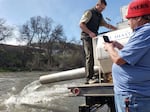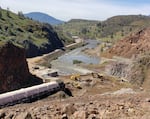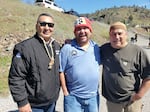Deconstruction of three dams on the Klamath River is just weeks away, and this Tuesday, a small crowd gathered just below Iron Gate dam to celebrate another milestone: the first release of threatened coho salmon since three massive reservoirs were drained in January.

Arron "Troy" Hockaday documents the release of coho while Jeff Campbell, Fish Hatchery Manager at CDFW, makes sure all the fish make it out of the truck.
Juliet Grable / JPR
A truck containing several thousand yearling fish idled quietly while representatives from the California Department of Fish and Wildlife, the Quartz Valley Indian Tribe, Shasta Indian Nation, Karuk Tribe, and Yurok Tribe offered remarks.
“This is a great day,” said Arron “Troy” Hockaday, who serves on the Karuk Tribal Council. “It’s been a long time coming. I’m a fifth-generation fishermen; I started watching the decline of salmon in my early teens, in the 1980s.”
“We call this area K’íka·c’é·ki,” said Michael Olson, council member for the Shasta Indian Nation. “We’re here today to pray for the healing of that, and this river, and these fish. We need all three to be healthy for all of our people to be healthy.”
The fish were raised at nearby hatcheries; now they were about to begin their journey to the Pacific Ocean. CDFW staff backed the truck down the ramp and attached a large metal pipe to the back of the tank. Kenneth Brink, vice chairman for the Karuk Tribe, began to sing as fish poured through the pipe and into the river.
By the end of the week, the agency will have released 90,000 yearling coho as well as 400,000 Chinook salmon fry into the Klamath River. Conceivably, in several years some of these fish could return to newly accessible habitat above the dams to spawn. For many present, the fish represent hope, something positive to combat the poverty and epidemics of suicide, substance abuse, and murdered and missing indigenous people that have plagued Klamath River tribes since the taking of their lands and destruction of their ways of life.
“There was a time when I was a young man when my situation was hopeless; my elders and my grandparents were hopeless,” said Phillip Williams, who serves on the Yurok Tribal Council. Now, he said, “The tribe will be healing right alongside the river.”
The legacy of the dams
Just as the coho were being sent on their oceanward journey, excavators were working at the base of Iron Gate dam, removing the last remnants of the deconstructed Iron Gate fish hatchery. The facility, which began operating in 1965, was one of several built to compensate for the loss of upriver spawning grounds when the dams were erected.
As part of the dam removal plan, a new hatchery has been built at nearby Fall Creek to replace the one at Iron Gate. CDFW decided to truck fish around Iron Gate dam following a debacle in late February, when they released 830,000 fall Chinook fry from the new hatchery into Fall Creek. The agency believes virtually all of the fish perished from “gas bubble disease” — a condition similar to “the bends” — after swimming through the pressurized, turbulent waters in the outlet tunnel at the base of Iron Gate dam.
The loss won’t affect overall goals, said Jason Roberts, environmental program manager at CDFW. Later this spring, the agency plans to release 1.75 million Chinook smolts, which are at least one year old.

Operators use excavators to remove the remnants of a fish hatchery at the base of Iron Gate dam.
Juliet Grable / JPR
PacifiCorp, the former owner of the Lower Klamath Project dams, will fund the Fall Creek hatchery for eight years. At that point, biologists will assess whether it should stay in service.
“I think everyone’s hope is that this river doesn’t need the hatchery in eight years, and that it’s thriving,” said Roberts.
Hatchery fish supplement wild populations and their numbers stay relatively constant, said Brett Kormos, environmental program manager at CDFW’s Coastal Fisheries Program. The Klamath River is “special,” Kormos added. “The vast majority of the fish in this river are natural origin fish, year over year. It’s mostly a naturally producing body of water, which is really different from how things are in the Central Valley and Sacramento River Basin these days.”
That’s not to say Klamath River salmon are healthy. Klamath River coho are federally listed as threatened, and Chinook runs are a fraction of what they once were. Salmon runs across the West are suffering from the cumulative effects of habitat loss, water withdrawals, and ocean warming associated with climate change. For the second year in a row, the Pacific Fishery Management Council recommended in mid-April that commercial and recreational fishing in California coastal waters be suspended.
Habitat loss, disease, river flows and temperatures have hurt Klamath River fish, said Kormos. The three former reservoirs behind the dams were like giant bathtubs; they heated and cooled slowly, creating unnatural temperature conditions on the river downstream.
“One of the immediate things we’re really encouraged to see is that the temperatures are responding in a more natural way that we’d expect to see with a river,” said Dan Chase, Director, Fisheries, Aquatics and Design at Resource Environmental Solutions, which is spearheading the restoration of the river. “We’re seeing earlier spring warming, which is good for fish.”
As was expected, an enormous pulse of built-up sediment released from behind the dams when the reservoirs were drawn down this January compromised water quality downstream. The river turned muddy and dissolved oxygen levels dipped. These spikes, though dramatic, have fallen within expected ranges, and water quality monitoring by Klamath River Renewal Corporation shows turbidity trending down. The Karuk Tribe has been inspecting fish in the main stem of the river and report that juvenile coho heading to the sea appear healthy and unaffected by the sediment load.
The Siskiyou County Board of Supervisors declared a state of emergency on March 26, citing water sampling from the Klamath River that showed levels of arsenic and lead above drinking water standards, and levels of several other heavy metals above the state’s “beneficial use” standard.
A new generation of stories
While they waited for more coho-bearing trucks to arrive, Hockaday, Williams, and Leaf Hillman, a Karuk tribal member, traded stories about the river, their families, and of course, fishing.
As Hockaday recollected, his grandmother described the river as narrower than it is today, with deep, cold pockets of water.
“The river used to freeze sometimes, and she’d go ice skating,” said Hockaday.

Phillip Williams, Arron "Troy" Hockaday, and Leaf Hillman share stories from times past as they celebrate the release of year-old coho salmon into the Klamath River.
Juliet Grable / JPR
Willliams recalled that starting when he was about 12, his grandfather liked to take him fishing for lamprey. “I would eel all I wanted and he’d sit there the whole time,” said Williams. They used dip nets or eel baskets to catch them.
“We always used socks,” said Hillman, describing how he would wade out into the river with socks on his hands, then feel around on the bottom for the sinuous lamprey.
These are the kinds of stories the men hope their children’s children will be able to tell someday. In a few years, Hockaday wants to bring his young grandson — the seventh generation of fishermen in his tribe — to witness some of the fish released this week return to their spawning grounds. By then, Iron Gate and the other two remaining dams will also be part of the past.